LVRG Scrapbook — Monday, May 10, 2010:
An Australian Georgist in London, April 2010
The purpose of the trip was to present the paper “Land-Backed Debt as a Revenue Base” at the IU Global Conference, London, April 26–30, 2010. I left little time for anything else. Nevertheless...
April 25: Royal Observatory, Greenwich
I stayed at Bentinck House Hotel because it was about 100 metres from the conference venue (School of Economic Science, 11 Mandeville Place). Due to “engineering works” in parts of the London Underground, I couldn't get from the hotel to Greenwich by the most direct route, and ended up travelling over part of the Jubilee Line Extension. That's the new railway that cost the taxpayers £3.5 billion but raised property values within 1000 yards of the stations by £13 billion. If 27% of the uplift in property values had been clawed back from the lucky owners — letting them keep the other 73% as a free gift — the line would have paid for itself without burdening any taxpayers who did not share in the benefit. But perhaps I digress.
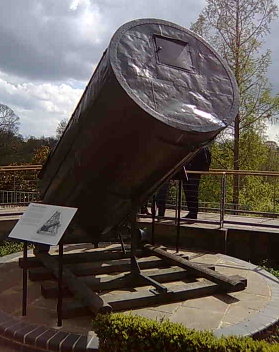 Left: This is what's left of the tube of William Herschel's
“40-foot” (48-inch f/10) telescope, which was built
between 1785 and 1789 and was the biggest telescope in the world until
1845. But Herschel himself found his earlier “20-foot”
telescope (with a 19-inch aperture) far more useful. The
“40-foot” was last used in 1815 and eventually
decommissioned in 1839. The rest of the tube was crushed by a falling
tree in 1867.
Left: This is what's left of the tube of William Herschel's
“40-foot” (48-inch f/10) telescope, which was built
between 1785 and 1789 and was the biggest telescope in the world until
1845. But Herschel himself found his earlier “20-foot”
telescope (with a 19-inch aperture) far more useful. The
“40-foot” was last used in 1815 and eventually
decommissioned in 1839. The rest of the tube was crushed by a falling
tree in 1867.
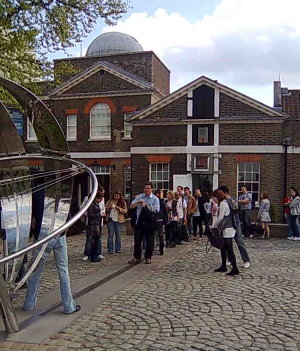 Right: Visitors line up to be photographed on the Prime
Meridian (0° longitude). The guy in the blue trousers, with
his top half obscured by the sculpture, is facing south, with his left
foot in the Eastern Hemisphere and his right foot in the Western
Hemisphere. The building in the background houses the meridian
telescopes, which were used for measuring positions of stars for
purposes including navigation. Speaking of which: to the west of the
courtyard (out of the picture) is the original building, including the
Astronomer Royal's residence, Christopher Wren's Octagon Room, and
the “Time Galleries” containing
John Harrison's four
marine chronometers, irreverently referred to as H1, H2, H3 and H4.
The oldest and and most important unsolved problem in navigation was
the measurement of longitude at sea. Harrison's aim was to build a
seagoing clock indicating Greenwich time with great accuracy,
notwithstanding the unpredictable motions and variable temperatures to
which ship-borne instruments are subjected. Comparison between
Greenwich time and local time (determined from astronomical
observations) would then yield the longitude of the ship. Although
recognition was scandalously slow, H4 proved accurate enough for the
job. Larcum Kendall made three imitations of H4, known as K1 (an
exact copy), K2 (a simpler version), and K3 (a cheap imitation). K1
accompanied James Cook on his second and third voyages and remained in
service for more than 30 years. K2, although less accurate, went to
the Arctic with Phipps (see below) and then to Australia and Pitcairn
Island on the Bounty. K3 went with Cook on his third voyage
and with Matthew Flinders to Australia, but was found wanting.
Right: Visitors line up to be photographed on the Prime
Meridian (0° longitude). The guy in the blue trousers, with
his top half obscured by the sculpture, is facing south, with his left
foot in the Eastern Hemisphere and his right foot in the Western
Hemisphere. The building in the background houses the meridian
telescopes, which were used for measuring positions of stars for
purposes including navigation. Speaking of which: to the west of the
courtyard (out of the picture) is the original building, including the
Astronomer Royal's residence, Christopher Wren's Octagon Room, and
the “Time Galleries” containing
John Harrison's four
marine chronometers, irreverently referred to as H1, H2, H3 and H4.
The oldest and and most important unsolved problem in navigation was
the measurement of longitude at sea. Harrison's aim was to build a
seagoing clock indicating Greenwich time with great accuracy,
notwithstanding the unpredictable motions and variable temperatures to
which ship-borne instruments are subjected. Comparison between
Greenwich time and local time (determined from astronomical
observations) would then yield the longitude of the ship. Although
recognition was scandalously slow, H4 proved accurate enough for the
job. Larcum Kendall made three imitations of H4, known as K1 (an
exact copy), K2 (a simpler version), and K3 (a cheap imitation). K1
accompanied James Cook on his second and third voyages and remained in
service for more than 30 years. K2, although less accurate, went to
the Arctic with Phipps (see below) and then to Australia and Pitcairn
Island on the Bounty. K3 went with Cook on his third voyage
and with Matthew Flinders to Australia, but was found wanting.
April 28: A walk around town
The afternoon of the 28th was free until a scammer intervened. On the evening of the 27th I received a message from a hacked email account, purportedly from a Melbourne colleague stranded in London and needing a “loan” through Western Union. Was it a fluke that I received this message while I myself was in London for the first time? Yes! But confirmation that the account had been hacked did not come until the morning of the 29th, so that the matter distracted me throughout the 28th. I started the afternoon by doing what a scammer would not want me to do: I inspected the address at which the scammer wanted the money — 54 Hallam St, London, W1N 5LF — and found that it was inaccessible due to construction work. Then I missed the last entry to St Paul's Cathedral by about two minutes and didn't get another chance to visit. But not all was lost...
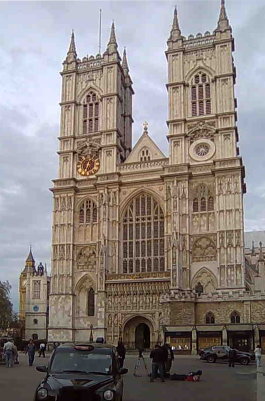 Right: You can't take photos inside Westminster Abbey. But you
can walk on the tombstones. Some of the inscriptions are almost worn
away. And if the inscriptions can hardly be seen, even visitors who
wish to avoid walking on them may walk on them without knowing it.
Isaac Newton's grave will not suffer that fate as long as it remains
roped off. Some in-floor tombstones are marked by free-standing
signs, so that if you stand back far enough to read the sign, you
won't step on the tombstone; one grave protected in this way is that
of George Frideric Handel (whose year of birth is given as 1684, not
1685, because he was born on Feb.23, whereas the beginning of
the year was then taken as March 25). But Henry Purcell's stone
is neither roped nor signed — which may explain why, as the
Abbey website puts it, “The gravestone for Frances and Henry has
been re-cut several times and is now inlaid with brass letters.”
Who else grabbed my attention? In the North Choir Aisle with Purcell
is Ralph Vaughan Williams. In the Poet's Corner with Handel are
Browning, Chaucer, Congreve, Dickens, Dryden, Thomas Hardy,
Dr Johnson, Kipling, Sheridan, Tennyson, and Thomas Babington
Macaulay — who allegedly said “The law of gravitation
would not now be accepted if it interfered with vested
interests.” In the Nave with Newton are Attlee, Chamberlain,
Darwin, Ben Jonson, Livingston, Rutherford, J.J. Thomson,
Sidney and Beatrice Webb, and King St Edward the Confessor. Other
monarchs buried elsewhere in the Abbey include Henry VII, the
last king of England to “live of his own”, and
Elizabeth I, who wondered why her realm was full of
”paupers, paupers, everywhere”. The answer is to be found
in the private land grabs facilitated by
the guy
in between, who is appropriately
buried elsewhere, and whose example is now being followed in connection
with water and other natural resources, pollution rights,
electromagnetic spectrum, and even things that are not scarce,
including information (e.g. genetic codes and traditional medicine),
and trivial but indispensable ideas (which are now called inventions).
But perhaps I digress.
Right: You can't take photos inside Westminster Abbey. But you
can walk on the tombstones. Some of the inscriptions are almost worn
away. And if the inscriptions can hardly be seen, even visitors who
wish to avoid walking on them may walk on them without knowing it.
Isaac Newton's grave will not suffer that fate as long as it remains
roped off. Some in-floor tombstones are marked by free-standing
signs, so that if you stand back far enough to read the sign, you
won't step on the tombstone; one grave protected in this way is that
of George Frideric Handel (whose year of birth is given as 1684, not
1685, because he was born on Feb.23, whereas the beginning of
the year was then taken as March 25). But Henry Purcell's stone
is neither roped nor signed — which may explain why, as the
Abbey website puts it, “The gravestone for Frances and Henry has
been re-cut several times and is now inlaid with brass letters.”
Who else grabbed my attention? In the North Choir Aisle with Purcell
is Ralph Vaughan Williams. In the Poet's Corner with Handel are
Browning, Chaucer, Congreve, Dickens, Dryden, Thomas Hardy,
Dr Johnson, Kipling, Sheridan, Tennyson, and Thomas Babington
Macaulay — who allegedly said “The law of gravitation
would not now be accepted if it interfered with vested
interests.” In the Nave with Newton are Attlee, Chamberlain,
Darwin, Ben Jonson, Livingston, Rutherford, J.J. Thomson,
Sidney and Beatrice Webb, and King St Edward the Confessor. Other
monarchs buried elsewhere in the Abbey include Henry VII, the
last king of England to “live of his own”, and
Elizabeth I, who wondered why her realm was full of
”paupers, paupers, everywhere”. The answer is to be found
in the private land grabs facilitated by
the guy
in between, who is appropriately
buried elsewhere, and whose example is now being followed in connection
with water and other natural resources, pollution rights,
electromagnetic spectrum, and even things that are not scarce,
including information (e.g. genetic codes and traditional medicine),
and trivial but indispensable ideas (which are now called inventions).
But perhaps I digress.
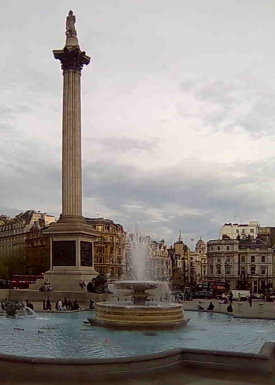 Left: In 1773, the 14-year-old Horatio Nelson served as a
midshipman aboard HMS Carcass (yep, that was its name) on
its voyage to the Arctic, accompanied by HMS Racehorse,
under the overall command of Constantine John Phipps. The voyage
reached latitude 80°37' but failed in its bid to find the
Northwest Passage. The ships carried what Stephanie Jones and
Jonathan Gosling describe as “two Harrison chronometers”
(Nelson's way: leadership lessons from the great commander,
Nicholas Brealey Publishing, p.28, via Google Books!), although
in fact the voyage carried one timekeeper by Kendall and two by
John Arnold.
Left: In 1773, the 14-year-old Horatio Nelson served as a
midshipman aboard HMS Carcass (yep, that was its name) on
its voyage to the Arctic, accompanied by HMS Racehorse,
under the overall command of Constantine John Phipps. The voyage
reached latitude 80°37' but failed in its bid to find the
Northwest Passage. The ships carried what Stephanie Jones and
Jonathan Gosling describe as “two Harrison chronometers”
(Nelson's way: leadership lessons from the great commander,
Nicholas Brealey Publishing, p.28, via Google Books!), although
in fact the voyage carried one timekeeper by Kendall and two by
John Arnold.
April 30: The last full day
A constant source of confusion for visitors is that the streets change their names for no reason. To say that the conference venue is at the intersection of Mandeville Place and Hinde St is not the full story, because this intersection is where Mandeville Place becomes Thayer St. Further north, it becomes Marlybone High St. A hundred metres to the south, it crosses Wigmore St and becomes James St. Another 200 metres south, it crosses Oxford St and becomes Gilbert St. Wigmore St, a more significant thoroughfare, extends to the W/SW as Portman Square and Seymour St, and to the E/NE as Cavendish Place and Mortimer St. Hinde St, just to keep you guessing, does not change its name where it crosses Mandeville Place, but does change its name at the next intersection to the E/NE, where it becomes Bentinck St. All clear now?
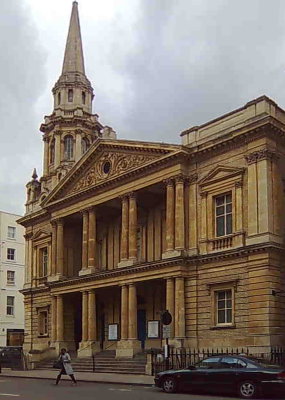 Left: Hinde Street Methodist Church, located diagonally across
the intersection from the conference venue, but seen here from the
E/SE, i.e. from near the intersection where Hinde St becomes Bentinck
St.
Left: Hinde Street Methodist Church, located diagonally across
the intersection from the conference venue, but seen here from the
E/SE, i.e. from near the intersection where Hinde St becomes Bentinck
St.
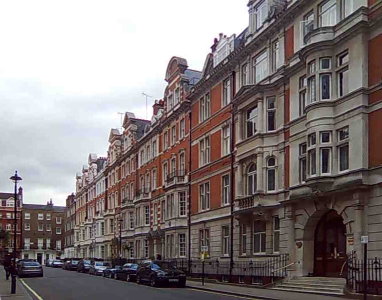 Left: View to the east along Bentinck St, including the
Bentinck House Hotel (No.20). Vertical lines courtesy of the
“perspective” transformation in
the GIMP; all photos
but the first incorporate some perspective adjustment.
Left: View to the east along Bentinck St, including the
Bentinck House Hotel (No.20). Vertical lines courtesy of the
“perspective” transformation in
the GIMP; all photos
but the first incorporate some perspective adjustment.
Return
The Henry Report and the Government's response were released on May 2, while I was about 33,000 feet above Indonesia. I got home late in the evening, and worked through the night preparing a brief commentary.
[Posted by Gavin R. Putland at tribune.grputland.com, May 10, 2010. Edited Jul.24, 2010. Relocated and purged of dead links, Apr.5, 2012. Edited Jul.13, 2014.]



